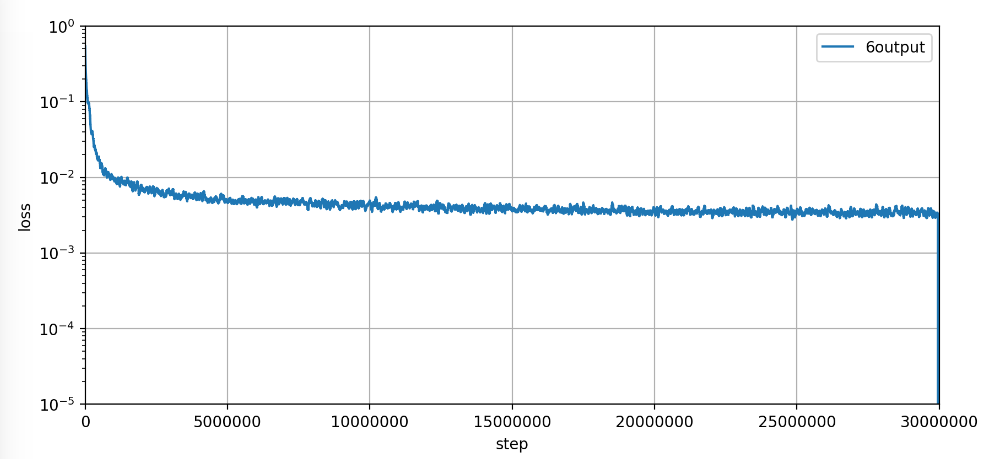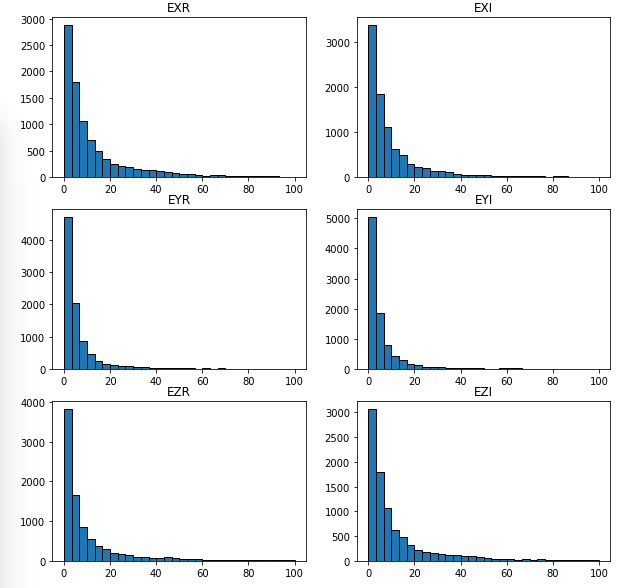動作環境
GeForce GTX 1070 (8GB)
ASRock Z170M Pro4S [Intel Z170chipset]
Ubuntu 16.04 LTS desktop amd64
TensorFlow v1.1.0
cuDNN v5.1 for Linux
CUDA v8.0
Python 3.5.2
IPython 6.0.0 -- An enhanced Interactive Python.
gcc (Ubuntu 5.4.0-6ubuntu1~16.04.4) 5.4.0 20160609
GNU bash, version 4.3.48(1)-release (x86_64-pc-linux-gnu)
学習コードv0.1 http://qiita.com/7of9/items/5819f36e78cc4290614e
http://qiita.com/7of9/items/38cb4f686b65fa26bb51
の続き。
概要
This article is related to ADDA (light scattering simulator based on the discrete dipole approximation).
- TFRecordsを読込んで学習する
- input: 5 nodes
- output: 6 nodes
- サンプル数: 223,872
- 学習データ: ADDAにより計算した値
- #input
- x,y,z: dipole position
- refractive index: real and imaginary part
- #output
- initial values for linear equation solution for (x,y,z),(real,imaginary)
5次元関数の補間を学習させようとしている。
学習コード v0.14
出力層の値に関して「データの標準化」を行った。
出力層のnodeを6での学習。
stepを30,000,000まで行った。
learn_mr_mi_170722.py
import numpy as np
import tensorflow as tf
import tensorflow.contrib.slim as slim
import sys
"""
v0.14 Aug. 12, 2017
- increase step to 30,000,000
- learn with six output nodes
v0.13 Aug. 12, 2017
- standardize output with (mean, stddev)
+ read_and_decode() handles standardization
+ add standardize_data()
v0.12 Aug. 08, 2017
- handles only one output
- delete dropout
- add dropout
v0.3 - v0.11 Jul. 22 - Aug. 08, 2017
- play around with network parameters
+ batch size
+ learning rate
+ hidden layer nodes' numbers
v0.2 Jul. 22, 2017
- increase step from [30000] to [90000]
- change [capacity]
v0.1 Jul. 22, 2017
- increase network structure from [7,7,7] to [100,100,100]
- increase dimension of [input_ph], [output_ph]
- alter read_and_decode() to treat 5 input-, 6 output- nodes
- alter [IN_FILE] to the symbolic linked file
:reference: [learnExr_170504.py] to expand dimensions to [input:3,output:6]
=== branched from [learn_sineCurve_170708.py] ===
v0.6 Jul. 09, 2017
- modify for PEP8
- print prediction after learning
v0.5 Jul. 09, 2017
- fix bug > [Attempting to use uninitialized value hidden/hidden_1/weights]
v0.4 Jul. 09, 2017
- fix bug > stops only for one epoch
+ set [num_epochs=None] for string_input_producer()
- change parameters for shuffle_batch()
- implement training
v0.3 Jul. 09, 2017
- fix warning > use tf.local_variables_initializer() instead of
initialize_local_variables()
- fix warning > use tf.global_variables_initializer() instead of
initialize_all_variables()
v0.2 Jul. 08, 2017
- fix bug > OutOfRangeError (current size 0)
+ use [tf.initialize_local_variables()]
v0.1 Jul. 08, 2017
- only read [.tfrecords]
+ add inputs_xy()
+ add read_and_decode()
"""
# codingrule: PEP8
IN_FILE = 'LN-IntField-Y_170722.tfrecords'
def standardize_data(ax, mean, stddev):
return (ax - mean) / stddev
def read_and_decode(filename_queue):
reader = tf.TFRecordReader()
_, serialized_example = reader.read(filename_queue)
features = tf.parse_single_example(
serialized_example,
features={
'xpos_raw': tf.FixedLenFeature([], tf.string),
'ypos_raw': tf.FixedLenFeature([], tf.string),
'zpos_raw': tf.FixedLenFeature([], tf.string),
'mr_raw': tf.FixedLenFeature([], tf.string),
'mi_raw': tf.FixedLenFeature([], tf.string),
'exr_raw': tf.FixedLenFeature([], tf.string),
'exi_raw': tf.FixedLenFeature([], tf.string),
'eyr_raw': tf.FixedLenFeature([], tf.string),
'eyi_raw': tf.FixedLenFeature([], tf.string),
'ezr_raw': tf.FixedLenFeature([], tf.string),
'ezi_raw': tf.FixedLenFeature([], tf.string),
})
xpos_raw = tf.decode_raw(features['xpos_raw'], tf.float32)
ypos_raw = tf.decode_raw(features['ypos_raw'], tf.float32)
zpos_raw = tf.decode_raw(features['zpos_raw'], tf.float32)
mr_raw = tf.decode_raw(features['mr_raw'], tf.float32)
mi_raw = tf.decode_raw(features['mi_raw'], tf.float32)
exr_raw = tf.decode_raw(features['exr_raw'], tf.float32)
exi_raw = tf.decode_raw(features['exi_raw'], tf.float32)
eyr_raw = tf.decode_raw(features['eyr_raw'], tf.float32)
eyi_raw = tf.decode_raw(features['eyi_raw'], tf.float32)
ezr_raw = tf.decode_raw(features['ezr_raw'], tf.float32)
ezi_raw = tf.decode_raw(features['ezi_raw'], tf.float32)
xpos_org = tf.reshape(xpos_raw, [1])
ypos_org = tf.reshape(ypos_raw, [1])
zpos_org = tf.reshape(zpos_raw, [1])
mr_org = tf.reshape(mr_raw, [1])
mi_org = tf.reshape(mi_raw, [1])
exr_org = tf.reshape(exr_raw, [1])
exi_org = tf.reshape(exi_raw, [1])
eyr_org = tf.reshape(eyr_raw, [1])
eyi_org = tf.reshape(eyi_raw, [1])
ezr_org = tf.reshape(ezr_raw, [1])
ezi_org = tf.reshape(ezi_raw, [1])
# input
wrk = [xpos_org[0], ypos_org[0], zpos_org[0], mr_org[0], mi_org[0]]
inputs = tf.stack(wrk)
# for standardization
# obtained from [calc_mean_std_170812.py]
means = (0.000000, 0.000000, 0.018333, 0.011257, 0.000000, 0.000000)
stddevs = (0.108670, 0.079414, 0.704788, 0.579868, 0.167189, 0.271590)
# --- w/o standardization
# out_exr = exr_org[0]
# --- w/ standardization
out_exr = standardize_data(exr_org[0], means[0], stddevs[0])
out_exi = standardize_data(exi_org[0], means[1], stddevs[1])
out_eyr = standardize_data(eyr_org[0], means[2], stddevs[2])
out_eyi = standardize_data(eyi_org[0], means[3], stddevs[3])
out_ezr = standardize_data(ezr_org[0], means[4], stddevs[4])
out_ezi = standardize_data(ezi_org[0], means[5], stddevs[5])
# --- six outputs
wrk = [out_exr, out_exi,
out_eyr, out_eyi,
out_ezr, out_ezi]
# --- single output
# wrk = [out_ezi]
#
outputs = tf.stack(wrk)
return inputs, outputs
def inputs_xy():
filename = IN_FILE
filequeue = tf.train.string_input_producer(
[filename], num_epochs=None)
in_org, out_org = read_and_decode(filequeue)
return in_org, out_org
in_orgs, out_orgs = inputs_xy()
batch_size = 2 # [2]
# Ref: cifar10_input.py
min_fraction_of_examples_in_queue = 0.2 # 0.4
NUM_EXAMPLES_PER_EPOCH_FOR_TRAIN = 223872 # 223872 or 9328
min_queue_examples = int(NUM_EXAMPLES_PER_EPOCH_FOR_TRAIN *
min_fraction_of_examples_in_queue)
cpcty = min_queue_examples + 3 * batch_size
in_batch, out_batch = tf.train.shuffle_batch([in_orgs, out_orgs],
batch_size,
capacity=cpcty,
min_after_dequeue=batch_size)
input_ph = tf.placeholder("float", [None, 5])
output_ph = tf.placeholder("float", [None, 6]) # [6]
#output_ph = tf.placeholder("float", [None, 1]) # [6]
# network
hiddens = slim.stack(input_ph, slim.fully_connected, [30, 100, 100],
activation_fn=tf.nn.sigmoid, scope="hidden")
# --- six outputs
prediction = slim.fully_connected(hiddens, 6,
activation_fn=None, scope="output")
# --- only one output
# prediction = slim.fully_connected(hiddens, 1,
# activation_fn=None, scope="output")
loss = tf.contrib.losses.mean_squared_error(prediction, output_ph)
train_op = slim.learning.create_train_op(loss, tf.train.AdamOptimizer())
init_op = [tf.global_variables_initializer(), tf.local_variables_initializer()]
with tf.Session() as sess:
sess.run(init_op)
coord = tf.train.Coordinator()
threads = tf.train.start_queue_runners(sess=sess, coord=coord)
try:
for idx in range(30000000): # 3000000
inpbt, outbt = sess.run([in_batch, out_batch])
# print(outbt) # debug
_, t_loss = sess.run([train_op, loss],
feed_dict={input_ph: inpbt, output_ph: outbt})
if (idx + 1) % 100 == 0:
print("%d,%f" % (idx+1, t_loss))
# sys.stdout.flush() # not good for Matplotlib drawing
finally:
coord.request_stop()
# output the model
model_variables = slim.get_model_variables()
res = sess.run(model_variables)
np.save('model_variables_170722.npy', res)
coord.join(threads)
lossの経過
10時間ほどの処理で以下のlossの経過となった。
線形方程式の初期値の計算
上記の学習したネットワークを用いて線形方程式の初期値を計算した。
データの標準化を行っているため、EXR, EXIなどそれぞれに対して(mean, stddev)を用いて、元のスケールに戻している。
replace_by_NN_outputStdzd_170812.py
import numpy as np
import tensorflow as tf
import tensorflow.contrib.slim as slim
import sys
import os
import math
"""
v0.1 Aug. 12, 2017
- take [standardized output-node-data] into account
+ calculate original value using (mean, stddev)
+ add calc_inverse_standardized()
=== branched from [replace_by_NN_170729.py] ===
v0.4 Aug. 05, 2017
- remove os.remove() and use open(OUT_FILE, 'wb+')
v0.3 Jul. 29, 2017
- replace [exr, exi, eyr, eyi, ezr, ezi]
- add convolution calculations
+ calc_sigmoid()
+ add calc_conv()
v0.2 Jul. 29, 2017
- add calc_e2()
v0.1 Jul. 29, 2017
- read and output IntField-Y file without modification
"""
# on
# Ubuntu 16.04 LTS
# TensorFlow v1.1
# Python 3.5.2
# IPython 6.0.0 -- An enhanced Interactive Python.
def calc_sigmoid(x):
return 1.0 / (1.0 + math.exp(-x))
def calc_conv(src, weight, bias, applyActFnc):
wgt = weight.shape
conv = [0.0] * bias.size
# weight
for idx2 in range(wgt[1]):
tmp_vec = weight[:, idx2] * src[:]
conv[idx2] = tmp_vec.sum()
# bias
for idx2 in range(wgt[1]):
conv[idx2] = conv[idx2] + bias[idx2]
# activation function
if applyActFnc:
for idx2 in range(wgt[1]):
conv[idx2] = calc_sigmoid(conv[idx2])
return conv # return list
def calc_e2(xr, xi, yr, yi, zr, zi):
xx = xr*xr + xi*xi
yy = yr*yr + yi*yi
zz = zr*zr + zi*zi
return (xx + yy + zz)
def calc_inverse_standardized(aval, mean, stddev):
return (aval * stddev + mean)
def calc_original(exr, exi, eyr, eyi, ezr, ezi):
# for standardization
# obtained from [calc_mean_std_170812.py]
means = (0.000000, 0.000000, 0.018333, 0.011257, 0.000000, 0.000000)
stddevs = (0.108670, 0.079414, 0.704788, 0.579868, 0.167189, 0.271590)
exr = calc_inverse_standardized(exr, means[0], stddevs[0])
exi = calc_inverse_standardized(exi, means[1], stddevs[1])
eyr = calc_inverse_standardized(eyr, means[2], stddevs[2])
eyi = calc_inverse_standardized(eyi, means[3], stddevs[3])
ezr = calc_inverse_standardized(ezr, means[4], stddevs[4])
ezi = calc_inverse_standardized(ezi, means[5], stddevs[5])
return exr, exi, eyr, eyi, ezr, ezi
INP_FILE = 'LN-IntField-Y.in'
OUT_FILE = 'IntField-Y.out_170729'
NETWORK_FILE = 'LN-model_variables_170722.npy'
HEADER_TXT = 'x y z |E|^2 Ex.r Ex.i Ey.r Ey.i Ez.r Ez.i'
dat = np.genfromtxt(INP_FILE, delimiter=' ',
skip_header=1) # skip header line
model_var = np.load(NETWORK_FILE)
# TODO: 0m > runtime parameter for real(m) and imag(m)
amr = 1.45
ami = 0.0001
with open(OUT_FILE, 'wb+') as fhndl:
# line 1
hdr = np.array(HEADER_TXT).reshape(1,)
np.savetxt(fhndl, hdr, delimiter=' ', fmt='%s')
# line 2 ..
for aline in dat:
ax, ay, az = aline[0:3]
# e2 = aline[3]
exr, exi = aline[4:6]
eyr, eyi = aline[6:8]
ezr, ezi = aline[8:10]
# input layer (5 nodes)
inlist = (ax, ay, az, amr, ami)
# hidden layer 1
cnv = calc_conv(inlist, model_var[0], model_var[1], applyActFnc=True)
# hidden layer 2
cnv = calc_conv(cnv, model_var[2], model_var[3], applyActFnc=True)
# hidden layer 3
cnv = calc_conv(cnv, model_var[4], model_var[5], applyActFnc=True)
# output layer
cnv = calc_conv(cnv, model_var[6], model_var[7], applyActFnc=False)
# print(exr, exi, eyr, eyi, ezr, ezi)
# print(cnv)
# sys.exit()
exr, exi = cnv[0:2]
eyr, eyi = cnv[2:4]
ezr, ezi = cnv[4:6]
# from [standardized] to [original]
res = calc_original(exr, exi, eyr, eyi, ezr, ezi)
exr, exi, eyr, eyi, ezr, ezi = res
e2 = calc_e2(exr, exi, eyr, eyi, ezr, ezi)
res = ax, ay, az, e2, exr, exi, eyr, eyi, ezr, ezi
np.savetxt(fhndl, np.c_[res], delimiter=' ', fmt='%.10f')
計算した初期値と学習元の初期値との相対誤差は以下のようになった。
出力ノードの「データの標準化」前と比べると、EXR, EXIに関して相対誤差が小さくなった。
しかしながら、5%以上の大きな誤差はまだ残っている。
学習結果を用いた計算
$ ./adda -m 1.45 0.0001 -grid 26 -init_field read REPLACE_NN_170812/IntField-Y.out_170729
all data is saved in 'run410_sphere_g26_m1.45'
box dimensions: 26x26x26
lambda: 6.283185307 Dipoles/lambda: 14.5
Required relative residual norm: 1e-05
Total number of occupied dipoles: 9328
Memory usage for MatVec matrices: 5.3 MB
Calculating Green's function (Dmatrix)
Fourier transform of Dmatrix......
Initializing FFTW3
Total memory usage: 9.0 MB
here we go, calc Y
CoupleConstant:0.005318998739+1.990081942e-05i
x_0 = from file REPLACE_NN_170812/IntField-Y.out_170729
RE_000 = 1.1570404113E-01
RE_001 = 6.0894333505E-02 +
RE_002 = 4.4600134874E-02 +
RE_003 = 3.1943097684E-02 +
RE_004 = 2.2380539987E-02 +
RE_005 = 1.6410557275E-02 +
RE_006 = 1.3967208832E-02 +
RE_007 = 1.3689525522E-02 +
RE_008 = 1.1822133975E-02 +
RE_009 = 1.0609063790E-02 +
RE_010 = 8.3262641152E-03 +
RE_011 = 6.3993162932E-03 +
RE_012 = 6.3410178166E-03 +
RE_013 = 6.3465585303E-03 -
RE_014 = 4.3573570592E-03 +
RE_015 = 3.3114292846E-03 +
RE_016 = 2.7530688379E-03 +
RE_017 = 1.8843547742E-03 +
RE_018 = 1.2130583207E-03 +
RE_019 = 1.1483435274E-03 +
RE_020 = 8.2036660829E-04 +
RE_021 = 7.0364052512E-04 +
RE_022 = 6.8000713077E-04 +
RE_023 = 6.2880348695E-04 +
RE_024 = 6.6688043113E-04 -
RE_025 = 4.7428484132E-04 +
RE_026 = 4.2292500513E-04 +
RE_027 = 1.5796151197E-04 +
RE_028 = 1.2780606594E-04 +
RE_029 = 1.0438002750E-04 +
RE_030 = 1.1312258176E-04 -
RE_031 = 1.1640392250E-04 -
RE_032 = 7.8983092454E-05 +
RE_033 = 8.0795318221E-05 -
RE_034 = 4.4667978101E-05 +
RE_035 = 1.3100951627E-05 +
RE_036 = 1.5032473884E-05 -
RE_037 = 1.6034135382E-05 -
RE_038 = 1.5365968913E-05 -+
RE_039 = 9.6210061936E-06 +
Cext = 357.7377726
Qext = 3.556241483
Cabs = 0.2646836546
Qabs = 0.002631198225
出力ノードの「データの標準化」前と比べて目に見える改善はなかった。
- 初期誤差
- データの標準化前: 1.1679879124E-01
- データの標準化後: 1.1570404113E-01

